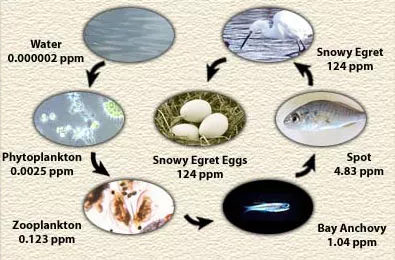
How can low levels of DDT in farm fields end up at high levels in ospreys?
Several different pesticides, an example of which is DDT, can be biomagnified by the food chain. The pesticides are used to kill insects, but run off farm fields into rivers, which empty into the salt marsh. Algae in the plankton absorb the DDT, concentrating in their bodies. Planktonic animals then eat the algae.
When small fish, such as bay anchovies, eat the plankton, they eat relatively more DDT because it is concentrated in the bodies of the prey. Each step up the food chain can concentrate a persistent pesticide such as DDT from 10 to 1000 times. The anchovies eat many planktonic animals over their lives, and each animal may contain a store of DDT. By the time the anchovy is eaten by a bigger fish, such as a croaker, it contains a much higher level of DDT than the water does. The croakers then concentrate the DDT just as the anchovies did, and animals that eat the croakers, such as ospreys, pelicans, and eagles, receive an even higher level of the DDT.
This effect is called biomagnification. Any persistent pollutant can be biomagnified in the food chain. Even though the level of the contaminant in the water may be very low, the level in the bodies of the top predators can be much higher. Because of the levels of DDT the birds were exposed to, their eggshells became so thin that they broke. The birds were unable to reproduce successfully and their numbers declined. Since DDT was banned, the numbers of these birds has increased.